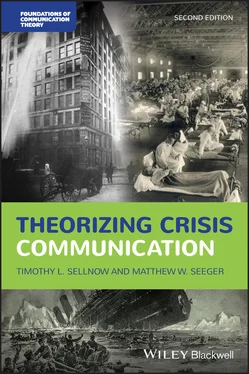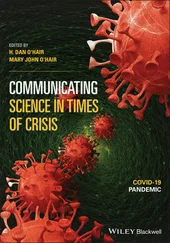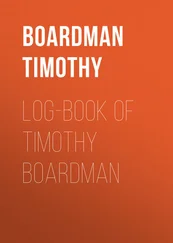Warnings often extend to offering recommendations from subject matter experts or emergency managers about actions that can be taken or avoided to reduce or mitigate the threats. This second dimension of warning is essentially persuasive, seeking to induce some action such as evacuation or shelter in place. Warnings also have an instructional dimension, indicating what people should do in response (Sellnow et al.,2017a). Lindell and Perry (2004) describe the various warning activities, questions, and outcomes associated with the stages of a crisis, presented in Table 3.1. Thus, warnings have both informative and persuasive dimensions, and principles of effectiveness in both forms of communication are important. Warnings are a form of specialized risk communication, as discussed in Chapter 8, designed to help receivers limit or mitigate harm.
Warnings are high-consequence messages with the potential to save lives and reduce harm (Seeger & Sellnow, 2016). If incorrect, late, or communicated ineffectively, however, warnings can cause needless disruption to communities and businesses as well as reduce effectiveness of later warnings. Warnings that recommend evacuations, for example, are some of the most challenging decisions made during disasters (Fairchild et al., 2006). Mandating populations to relocate creates the risk of additional harm, including traffic accidents and adverse health events. Conversely, evacuations can reduce death tolls, especially where there is sufficient lead time and when a specific area is affected, such as with hurricanes. Public warning systems have been an essential part of risk management from the middle ages when warning bells were used to signal threats. Warning signals such as fog horns and lighthouses for shipping, bells, whistles, and flashing lights for train crossings, and sirens for fires were used widely by the early 1900s. Federal legislation, as well as emerging tort law and rising public expectations, provided incentives for more effective warning systems (Egilman, 2006).
The decision to issue a warning often involves a variety of experts and officials, including emergency management professionals, subject matter experts, political actors, and elected officials (Sorensen, 2000). Subject matter experts, such as medical professionals, epidemiologists, engineers, meteorologists, and seismologists, provide technical information. Elected and appointed government and emergency management officials typically have final authority in issuing public warnings. In making decisions about issuing warnings, emergency managers and public officials appraise the threat based on available information, assess the consequences of issuing a warning versus not, and ask, which outcome will produce the least harm (Mileti & Sorenson, 1990)? The likelihood of harm, the scope of harm, the consequences of an inaccurate warning, as well as the consequences of failure to warn are all important considerations in the decision to warn. Assessment of impending risks almost always involves uncertainty, requiring an evaluation of the credibility of different sources of information about risks. Balancing risks and benefits also requires weighing competing values and assessing the context of the risk. “Obviously, public death and injury can result if withheld warnings are followed by disaster” (Mileti & Sorensen, 1990, pp. 2–9). In some cases, delaying the decision to issue a warning allows more information to be collected and evaluated and others consulted. Decisions may also be delegated to others. Delaying in the case of a time-sensitive risk can reduce the effectiveness of the warning. In some cases, standard decisional guides are used to issue warnings. The National Hurricane Center, for example, has a set of criteria for issuing tropical storm warning and watches, and hurricane warnings and watches are based largely on wind speed. In most cases, the decision to issue a warning is a judgment made in a high-risk situation with imperfect knowledge.
Although warnings are essential to limiting harm in many disaster contexts, they also cause social and economic disruption, public concern, and physical and psychological harm. Warnings that prove incorrect can reduce credibility, limit the effectiveness of subsequent warnings, and cause embarrassment (Mileti & Sorensen, 1990). This may discourage officials from issuing warnings. In addition, some officials may be reluctant to issue warnings because they believe the public will panic. The public panic disaster myth is well documented and is sometimes used to justify withholding warnings. Warnings rarely, if ever, cause panic, and, in fact, the more significant challenge is simply getting the public’s attention about an emerging risk. In addition, officials may feel that offering too much information is itself risky or that the public simply ignores warnings (Sorensen, 2000).
An additional consideration concerns the ethics of warning and involves questions of autonomy and beneficence (Egilman, 2006). Autonomy is part of a larger set of principles about the right of individuals to have access to information about issues that may affect them. Autonomy is closely associated with the communication ethic of significant choice and the principle of right to know. Withholding information reduces a person’s autonomy and their ability to make choices for themselves about the level of risk they accept. The right of access to information about risks is well established as both an ethical and legal obligation (Ulmer & Sellnow, 1997). Withholding such information may have legal implications in the event harm does occur. A second ethical principle, beneficence, is the ethical obligation to show charity, mercy, and kindness toward others by taking actions that benefit others. Beneficence is a “moral obligation to act for the others’ benefit, helping them to further their important and legitimate interests, often by preventing or removing possible harms” (Beauchamp, 2018). This imperative exists for all those in professional roles but may be especially significant in cases of emergencies where people face harm.
A final set of considerations for emergency managers are the legal consequences of failure to issue a warning when there is sufficient information to do so. In cases where harm does occur, individuals responsible for issuing warnings may face legal consequences. In the case of the 2014 Flint Water crisis, for example, officials chose not to issue warnings about an outbreak of Legionnaires’ disease, even though they had sufficient information to do so. The outbreak resulted in several deaths. As a consequence, managers, including top public health officials, have faced a series of legal charges up to and including manslaughter (Gable & Buehler, 2017). In a similar case, officials downplayed the risk of the 2009 earthquake in L’Aquila, Italy. Earthquakes are very difficult to predict and officials elected not to issue a warning in response to several minor seismic events. The subsequent earthquake killed more than 300 people and the officials were charged with manslaughter. While a post-crisis environment is often litigious, cases of criminal liability for emergency managers are quite rare.
Decisions about warnings occur within a complex, high-risk context where information is inadequate and different values, needs, and perspectives must be considered. Sorensen (2000) points out that “warning systems are complex, because they link many specialties and organizations – science (government and private), engineering, technology, government, news media, and the public” (p. 119). Decisions to warn require information from these various experts be reconciled and some level of consensus reached. Sometimes these decisions are wrong. The public may be warned of a crisis that never manifests or the public may not be warned and, subsequently, a crisis occurs, harming both people and property.
Читать дальше












